

JUNXIAO LONG
Study
Evaluation Research Based on
Shostakovich
Experience Design
Experience

The human-environment interaction is one of the major concerns for architects. In the era of AI, it has been endowed with broader meanings, extending from tangible physical spaces to the intangible meta-verse. How should architects position themselves in this fundamental transformation of human productivity? In this portfolio, I attempt to address this question by approaching it from various perspectives. RadicalChangesinInteractionbetweenPoepleandEnvironment



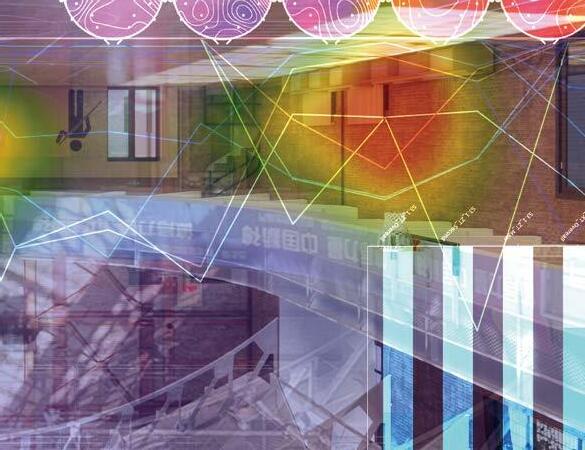




HOW CONTEXTS AFFECTS DECISION-MAKING?
Study of Cognitive Load Evaluation Research Based on VR, EEG and ERP

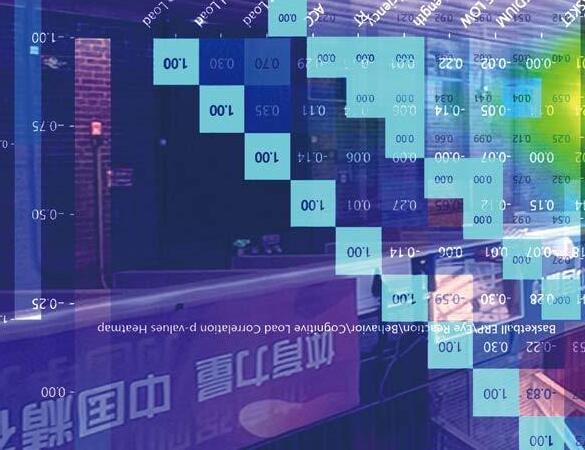

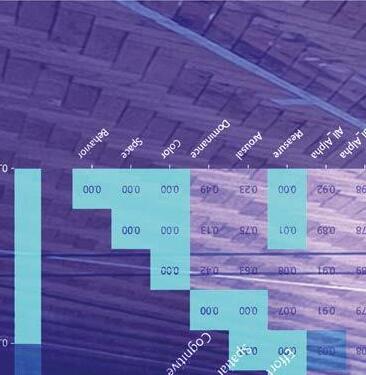
Full Name: Study on the Spatial “Comfort and Fluency” of University Recreational Center Based on Cognitive Load (Under Submission)
Master Capstone Thesis & Deisgn of March Tsinghua University
Individual Work Instructor: Prof.Weimin Zhuang & Ren Fei (Senior Chief Engineer of THAD)
Brief Introduction of the Experiments
This project aims to evaluate people's user experience in recreational center in VR environment.
Experience of people in recreational center can be divided into two main categories: 1. long-term experience; 2. short-term decision-making. Therefore, the author designs and conducts two experiments to depict these two experience: one is watching 360 videos in Cave VR environment to collect EEG and eyetracking recreations and the other is taking decision-making tests after watching to collect behavior features, ERPs and eyetracking reactions. Below are diagram of the experiemental flow and introduction of the paradigm used to test the performance of decision-making in sports.
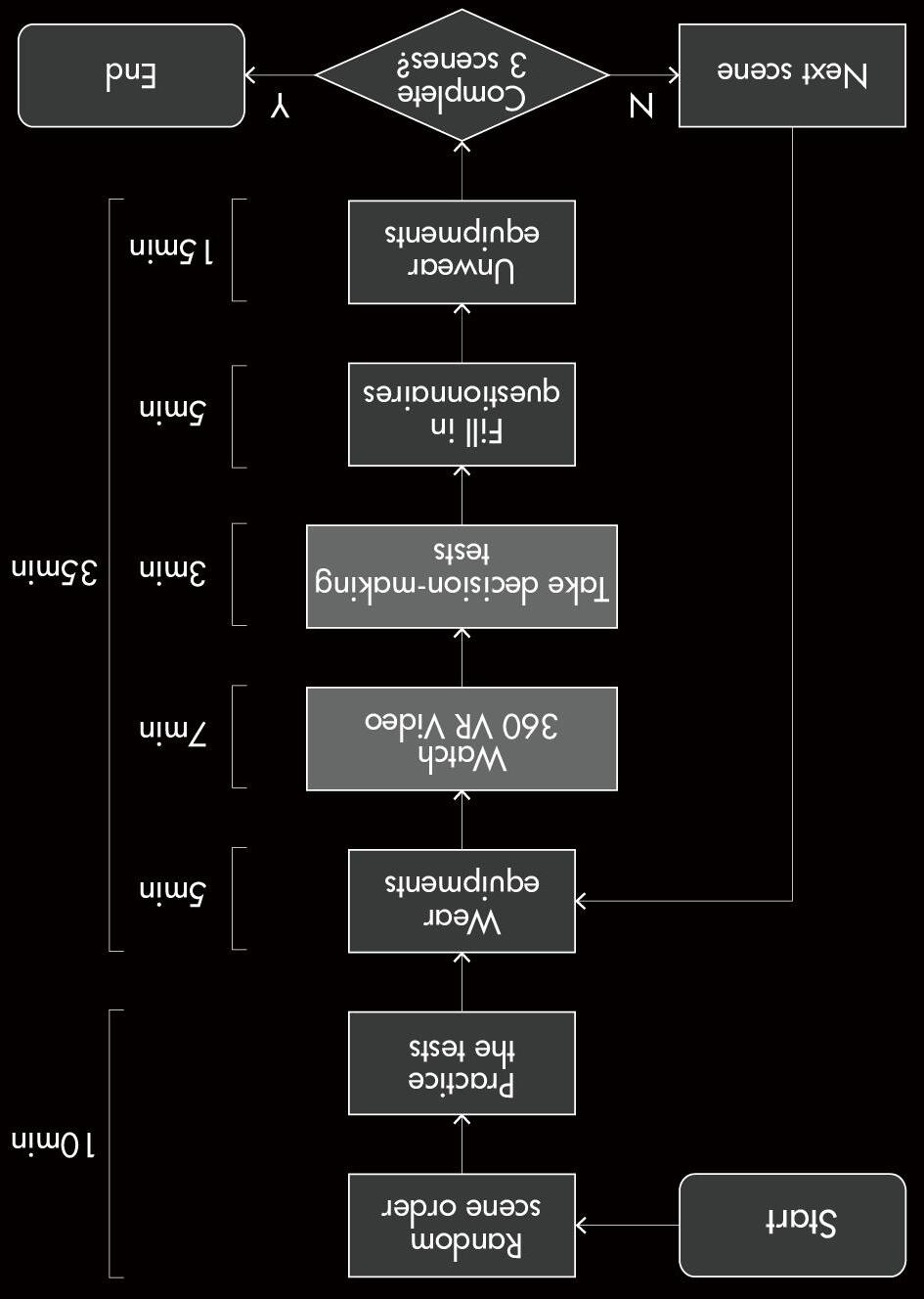
Long-term Experience of Recreational Center in VR
Right figures are shots of 360 videos of three different recreational centers in Tsinghua University. The author uses the following abbreviations to represent different venues:
BT = North Gymnasium;
XT1 = West Gymnasium Front Main Hall;
XT2 = West Gymnasium Back Main Hall;
ZT = Comprehensive Gymnasium.



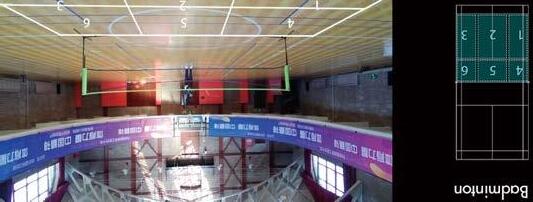



Stimuli of Short-term Decision-making in Sports
Currently, most research uses third-person camera to collect the stimuli of decision making in sports. In order to present a first-person perspective of situations on the court, the author adopts both third view camera and first-person observer. Below is the recording status of the observer.
Basketball stimuli are collected from BT, XT1 and ZT, while badminton stimuli are collected in XT1 and ZT only. (Due to venue regulations)

Evaluation Adjustment Factor
Basketball Stimulus Recording Observer Status

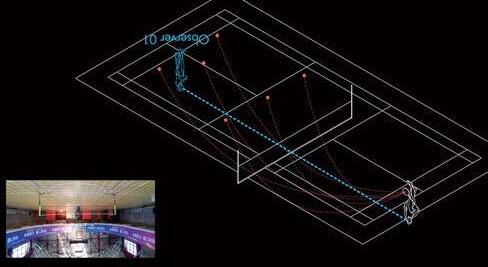
Badminton Stimulus Recording
The evaluation adopts Emotiv EPOC X 14 Channel Saline EEG Cap and SMI ETG eyetracker to record reactions of participants. Left below shows wearables in Cave VR environment.
However, there are significant differences between VR environment and reality that cannot be ignored. Therefore, the author further conducted experiments in reality to adjust the evaluation of VR environment. Right below shows wearables in reality.
Movements will cause strong artifacts in EEG recording, therefore, only eye-tracker is adopted in reality.


Eye-tracking Result Analysis (Main Halls)
Below shows heatmap of different perspectives of main halls. According to the main usage direction of the venues, gazing time of AOIs in main direction and second direction is stacked together in the bar chart.
BT's spatial features (redish categories) are most obvious across








four main hall. ZT's furniture features (yellow categories) attract more visual attention, this is because the second floor above in ZT consists of seats for audiences. XT's cultural information and distracts in space draw participants' attention, which can be a big influential factor to players.


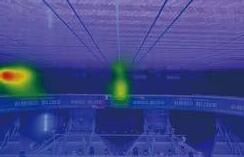







Subjective Result Analysis
The evaluation adopts Semantic Difference Scale (SD) to gauge spatial cognition. Pleasure, Arousal, Dominance Scale (PAD) to gauge emotional impact. NASA-TLX Scale to gauge cognitive load in performing tasks.
SD results show that BT is best in spatial cognition; XT1 is worst in spatial cognition; XT2 is worst in color experience, many participants reported that color in XT2 is dull and dark. ZT is balanced.


EEG Result Analysis
The difference of activities of different lobes in frontal area is believed to be a good indication of emotional reaction. The uprising power in right lobe is believed to be related with negative emotion, while the left lobe is the opposite. EEG power spectrum shows sigificant difference between venues (p<0.05 with fdr): the emotional experience of participants in BT,
BT shows the least cognitive load across venues, while XT and BT are equivalent. PAD shows no significant differences.



XT1, XT2 are equivalent and siginificantly more postive than ZT. This is because ZT uses blue and green as the main color and XT1, XT2 uses red as the main color.
In terms of viusal stimulating, which is believed to be related with activities in occipital area, there is no significant difference between venues.



Behavior Result Analysis
This research bases on behavior results to explain the performance of ERP, because behaviors are large-scale performance. Behavior data is based on the average performance of participants.
In terms of basketball, accuracy shows significant difference


ERP Results Analysis
P100, P200, N200 components of ERP are studied in this project both in latency and peak value.
Results show that peak value of P200 in parietal area presents

between venues: ZT is equivalent to BT and is better than XT. Reaction time shows no significant differences. In terms of badminton, there no significant difference between venues.

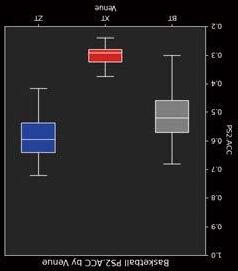
as: BT<XT1<ZT, which means performance in BT consume less attention resources. Latency of N100 in ftontal area presents as XT1<<BT<ZT.


Correlation and Adjustment Factor
For basketball, there is a weak negative correlation between the latency of the frontal P100 component and visual search efficienc). The latency of the frontal P200 component has a weak positive correlation with accuracy and a weak positive correlation with AOI_BASKET.
This suggests that earlier early awakening is positively related to visual search efficiency to some extent. Additionally, focusing attention on the basket earlier can improve accuracy to some extent.
Left below is the adjustment of VR and reality



Cognitive Load User Journey Map
Beside main halls, there are other spaces in recreational center.
The author defined these spaces into Entrance, Lobby, Passage and Exit and gave them codes like S1.1.01. S stands for Stay, P stands for Passby. 1.1.01 stands for first space in the sequence,



entry, first perspective. Through EEG, eye-tracking results, the author established the evaluation of each space and adjusted them using factor mentioned above.





Co Cognition is
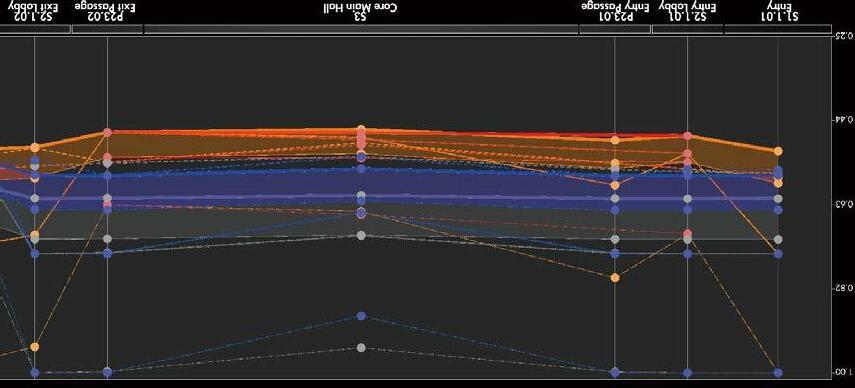
exploring environments, including taste, touch, hearing, etc. This process often occurs in the closer vicinity of the person. For deep learning, human spatial perception response


Renovation of West Gymnasium (XT), Tsinghua Univ. West Gymnasium of Tsinghua University is the earliest gymnasium in Tsinghua University, and probably in all Chinese universities. Front main hall was designed by Henry Murphy from 1916-1919, and back main hall was designed from 1931-1932. The middle hall of the gymnasium was the earliest indoor swimming pool in China where chairman Mao once came to swim.

The renovation mainly concerns front and back main hall. The strategy is derived from the evaluation results, and falls into three categories:
1. Enhancement of spatial experience;
2. Enhancement of performance efficiency;
3. Accessible design.








Enhancement of Spatial Experience
The strategies for improving spatial experience in the cognitive load comfort evaluation were explained, focusing on four main aspects:
1.Enhancing the attractiveness of spatial node: mainly targeting the current main entrance, front plaza, foyer space, and the corridor between the two gymnasiums, to enhance the aesthetic impact on users.

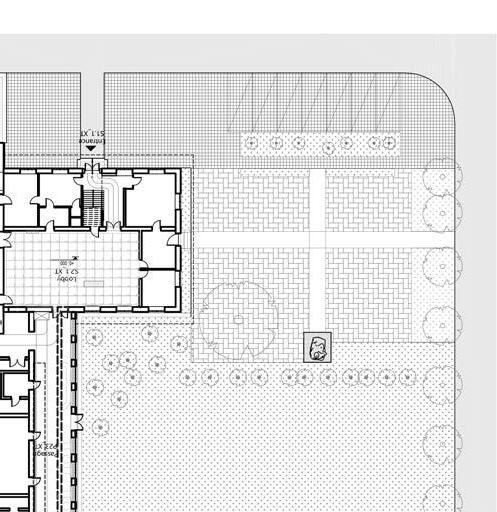
2. Increasing the spatial permeability of the main venue: partially opening the interfaces between the front, middle, and rear areas of the venue, allowing for active interaction between these spaces and the surrounding landscape resources.


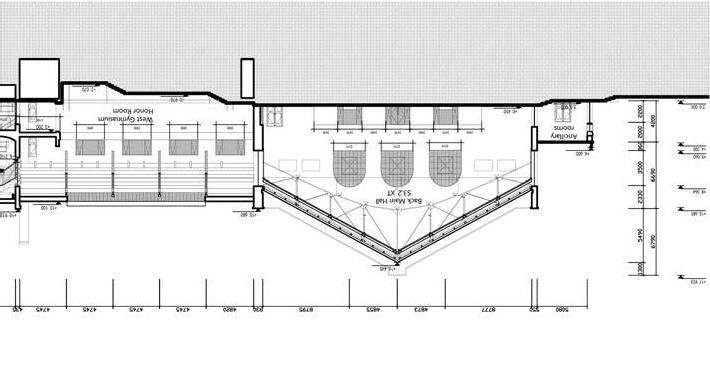
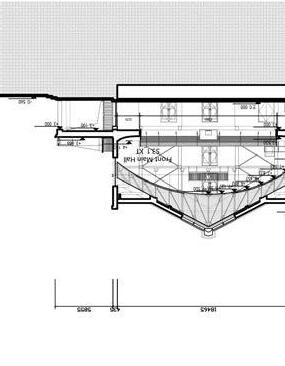
Front Hall Renovation Back Hall Renovation
Enhancement of Performance Efficiency (Front Hall)
The current issue in the front hall is that the excessive amount of spatial visual information affects sports decision-making. It is recommended to unify the forms and color elements of different interfaces.
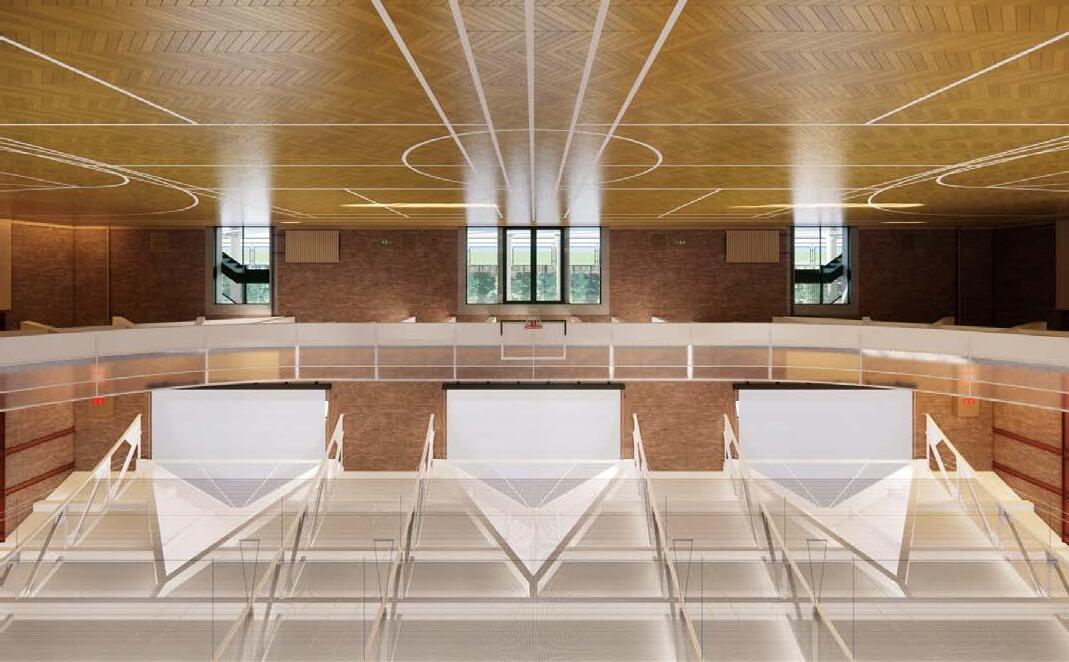
Enhancement of Performance Efficiency (Back Hall)
The current lighting design is unfavorable for badminton. It is being considered to add a layer of diffuse reflective membrane on the existing roof and use upward lighting to resolve the glare problem.

Accessible Design
Reorganize the types and forms of the visual guidance system according to functional use, and design a more effective spatial visual guidance system. Additionally, introduce furniture tailored to behavioral characteristics.



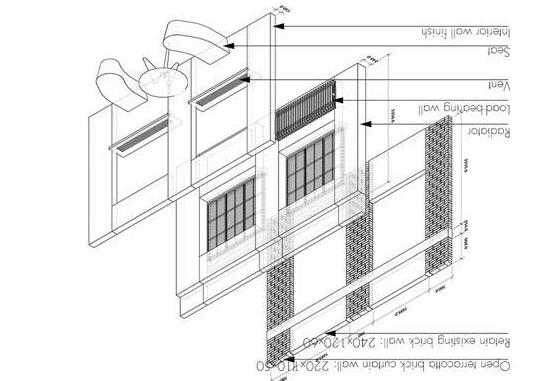




Radiator Cover Unit1
Radiator Cover Unit2
Visual Guidance & Visual Sign
Radiator Cover Unit3 Window Unit








02 HOW SPACE INFLUENCE HUMAN COGNITION?
Musum of Emotions
Paticipator y Design Based on AI, EEG and PAD
P.R.C National Project, Tsinghua University, Leaded by Prof.Weimin Zhuang
'Museum of Emotions' Competition Buildner.com
'AI+Architecture Edition 2' Design Workshop
Individual Work
Instructor: Prof.Weimin Zhuang & Ercument Gorgul



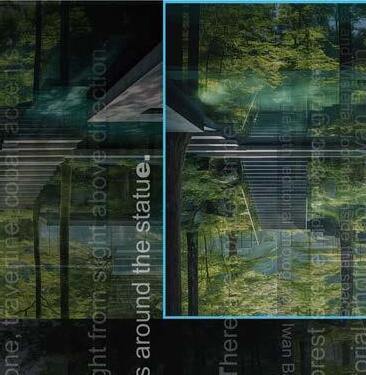
Background: AI-assisted Decision Making in Design
The traditional design process shows notable discrepancies and risks in terms of decisions and iteration frequency; along with client and user satisfaction. Introduction of AI into this process can enable reduced time in conceptualization, and a big potential for more scientific and user-engaged decision-making, enabling multiple iterations. Throughout the process, AI can also be trained on the feedback and decision patterns of clients and users, further optimizing the design process.

Framework: Human Emotion Dataset
Using the text generator I designed, a series of spatial scenes can be generated using the generative TEXT2IMAGE diffusion model. The outcome images are then rated by participants providing emotional assessments. A CNN model or other relevant models could be developed to train the AI to learn the correlation between the emotion data set and the input prompt. Due to the time constraint, I have used Stable Diffusion to generate the dataset for the experiment instead of training a CNN model.
With this protocol, it is possible to establish a direct connection between the written prompt and emotional outcome. In other words, AI can predict the emotional feedback of a scene based on its description.


Theory: Perception and Cognition of Space
Human- environment interaction relies on two processes: Perception and cognition. Cognition is mostly vision dominated, occuring in a wider range of surroundings. Perception relies on multiple sensory systems exploring environments, including taste, touch, hearing, etc. This process often occurs in the closer vicinity of the person. For deep learning, human spatial perception response can serve as a dataset.







HowEnivronmentRelatetoPeoplethroughPerceptionandCognition

Text Generator: Prompt Structure for Architecture
Based on natural language, spatial information can be grouped into three categories: "T for Tectonics, M for Materiality, and A for Ambiance." T encompasses basic scale, shapes, and details construction within a space; M focuses on the attributes of materials in different areas; A includes non-architectural elements like time, light, and plants, etc. Each prompt must begin with this overarching structure for consistency. After establishing the primary structure, content is further divided into secondary elements, such as Tn, Mn, and An in the diagram. The provided diagram illustrates a widely applicable prompt structure prototype, and by assigning weights to different elements, a dataset of visual stimuli with consistent difference can be efficiently generated.

































































Process
The experiment is divided into four steps: pre-experiment, selection, PAD assessment, and self-report.
The "PAD Scale" typically refers to a scale that measures three dimensions in emotional responses: Pleasure (P), Arousal (A), and Dominance (D).
Based on the established definitions of the PAD values for the eight basic emotions, conducted cluster analysis and correlation analysis to obtain conclusions.




Conclusion
In the positive group, there is a moderate negative correlation between Materiality and Dominance. In other words, the stronger the materiality is, the less control people feel over the space.
In the negative emotional space, the stronger the negative spatial Atmosphere is, the more negative the emotions become.
Taking a comprehensive view, Tectonics, Materiality, and Atmosphere are moderately negatively correlated with Valence and Dominance. Tectonics is strongly positively correlated with Valence.
Independence Test
P (Pleasure, Arousal) = 0.00026
P (Pleasure, Dominance) = 0.000096
P (Arousal, Dominance) = 0.000000 (P<0.05meansindependence)





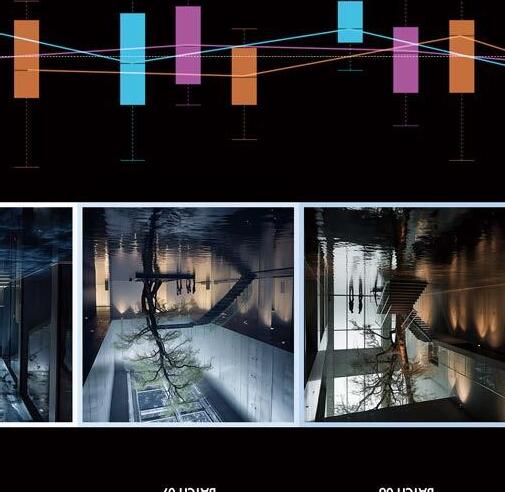




Confirmatory Design: Museum of Emotions
Using conclusions from AI experiments, the museum project designed two halls with the intention of evoking contrasting emotions. Remaining spaces serve the purpose of connecting between these emotions. The concept of the spatial sequence extends from the land into deep underwater, returning to the sea level at the end. This sequence of spaces allows individuals to follow an emotional journey starting from neutral state to positive emotions, then to slightly subdued negative emotions, returning to ultimately a calm state.

Experiment Setup
The experiment used an Emotiv Epoc X mobile EEG device (128 sampling rate, 14 channels) to collect physiological responses. Simultaneously, the SMI RED 500 eye tracker records scan path and regions of interest (ROIs) during image viewing.

Attention Allocation: EEG and Eye Movement
Brain responces from -200ms to 400ms are presented, sufficient to observe the impact.
Analysis focused on anterior frontal cortex reactions that are related to positive and negative emotional responses.
Results show enhanced positive responses in samples from BIN 01, 02, and 03, while BIN 04 and 05 exhibits calming effects. In eye-tracking analysis, individuals are observed to first focus on prominent figures in the space, followed by areas with special shapes. In places without specific design features, scan patterns tend to be more scattered.


Background: From Emperor to Everyone
Through the modern hydroponic experience, visitors can personally experience a contemporary form of agriculture while gaining insight into Changchunyuan's historical background as a place where emperors of the Qing Dynasty engaged in farming. This interactive experience not only sparks visitors' interest but also contributes to deepening their understanding and memory of historical culture.

Experience: Bending as a Farming Feature
Bending can be seen as a characteristic motion of farming. The museum design uses bending as a characteristic action, attempting to enable urbanites who are far away from the context of farming to experience the hardship of farming during a short period of time.




Method: EMG Data to Gauge Energy Consumption
The experiment utilizes Delsys EMG devices and Xsens motion capture wearable devices for real-time data acquisition of bending posture. The Delsys EMG sensors are mainly used in the field of Sports Physiology. MVN AWINDA is mainly used in the field of sports digitization.






Xs
Laboratory Setup
The laboratory is located at the Sports Rehabilitation Center of Tsinghua University. The experiment setup used a combination of polymer jump boxes in different heights to simulate different interfaces.
Experiment equipment includes planting tools (succulent plants, plant pots, shovels, spray bottles, beakers, planting soil), wearable devices (EEG equipment, Xsens devices), recording tools (Canon camera), and preparation tools (alcohol swabs, cushions).


Process
Participants are required to complete four planting tasks in 60s. After completing the tasks, participants are required to fill out a fatigue assessment scale, rest for 1 minute, and proceed to the next. There are 7 formal experiments in total.




Record
The experiment involved a total of 9 male participants, aged between 21 and 23, with no vigorous physical activity within the 24 hours before the experiment. Each participant was required to complete the described experimental tasks on 6 interfaces, and I recorded their actions while collecting real-time data throughout the process.

Conclusion
By processing electromyographic (EMG) data using Relative Integrated EMG (Relative IMEG) and Relative Root Mean Square (Relative RMS), features of different interfaces are compared.
The data indicate that 45-30 and 45-45 IFs effectively increase energy expenditure during the experience of farming activities. Additionally, most subjects exhibit a characteristic of greater muscle activation on the left side.






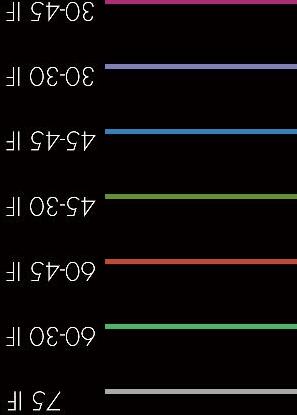

MUSCLE DISTRIBUTION RATE (MDR)






Ergnomic Design
According to the experimental findings, designs were developed around 30-30, 45-30, 45-45, 60-45, and the standard interface 75-30, which can increase muscle energy expenditure. The baseline was set at the 75-30 interface, a height that is generally comfortable for most individuals. The design takes into account considerations such as adjustable lighting and storage function. An assistive device has been set up on the left side of the human body to address the issue of easier fatigue in the left-side muscles.






Detailed Section
The detailed design carefully considers both the physical requirements for optimal crop growth and the interactive planting experience for visitors. The overall structure is constructed using 50x50x4.8mm angle steel. The selected interfaces for visitor planting include configurations of 75-30, 60-45, 45-45, and 30-30. Interfaces positioned above 200cm are designated for staff maintenance, with lighting seamlessly integrated into the load-bearing panels.
The planting system utilizes a drip irrigation setup, and water pumps in containers below 30cm supply nutrient solutions for cultivation. The floor ventilation system addresses the necessary temperature and humidity requirements for ideal crop growth. Adjustable lights cater to various interface heights.
At 75cm, an accessible facility aids standing up, specifically designed for the right-handed people. At 160cm, there is an LED screen attached to the toolbox, providing real-time information on crop growth, environmental CO2 concentration, etc.






Planting Space on 1F
The individual in the image is scanning the code to monitor the crop's growth progress. The hydroponic tanks in the foreground serve as interactive elements for individuals to engage with.





Planting Space on B1
The subterranean planting area is concealed beneath bags of planting soil, facilitating the cultivation of deep-rooted trees. These trees contribute ample shade and fresh air, thereby enriching the overall planting experience in the underground space.



Reception Hall
The four expansive glass structures introduce captivating and diverse patterns of light and shadow into the space, generating a vibrant atmosphere enriched by cultivated crops and greenery throughout the museum. Within the reception hall, a model of the planting unit is exhibited, offering visitors a more intuitive understanding of the system.


Breeding Hall
The breeding room necessitates stringent control over artificial environmental conditions. Different crop seeds are arranged on tall breeding racks, and individuals can tend to these crops using a device akin to a movable ladder, similar to those found in libraries.



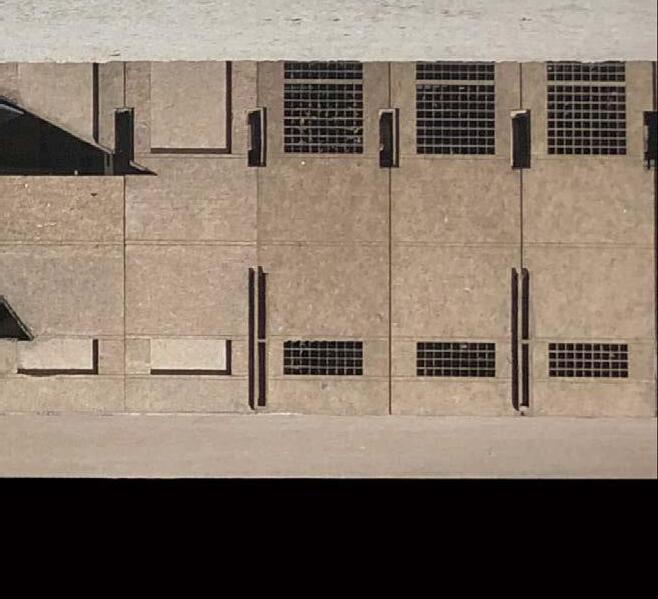







DMITRI SHOSTAKOVICH
1906.09--1975.08
Composer, Painist, Teacher
Bio
Shostakovich was a Soviet musician. He was considered one of the most influencial composers fo the 20th century. His music was full of emotional expression and deep thoughts of his time and his experience. His famous work including Symphony No. 5, Symphony No. 7, Jazz Suite No. 2,etc.
Relationship
With Joseph Stalin
Goals
- Shostakovich wants to use music to express his real thoughts and feelings.
- Shostakovich wants to use music to commorate his "vanished" loved ones.
-Shostakovich wants to use music to record the the darkness of Soviet Politics under the rule of Stalin.

Shostakovich kept a subtle and complex relationship with Joseph Stalin. On one hand, Stalin expressed open disagreements with some of Shostakovich's work. On the other hand, Stalin didn't execute Shostakovich like what he had done to other artists.Instead, he appreacited shostakoviche's talents very much, especially for his Symphony No.7. Therefore the music of Shostakovich is always full of contradictory and complicated expressions.
Pain Points
- Shostakovich felt hard to sleep at night because he was afraid of being arrested and executed unexpectedly.
- Shostakovich felt reluctant to express himself openly in the public.

Study on the Score of SymphonyNo.7

IannisXenakis-Pithoprakta(w/graphicalscore)
Shostakovich's Symphony No. 7 consists of four movements, titled "War," "Memories," "My Native Field," and "Victory." The first movement is renowned for its nearly 26-minute duration. Deviating from the traditional symphonic structure of "Exposition, Development, and Recapitulation," the first movement innovatively inserts an 11-section episode depicting the invasion of the troops. The symphony delineates four distinct images: the people, soldiers, troops, and the composer. A visualization method, invented by Iannis Xenakis, has been employed to analyze the visual presentation of these themes. This approach defines the character of each theme from the perspectives of rhythm, melodic trajectory, and the primary instruments used in the performance. Theme 01 People
Personality
-Introverted
-Reserved and conventional
-Cautious and thoughtful -Emotional and sensitive





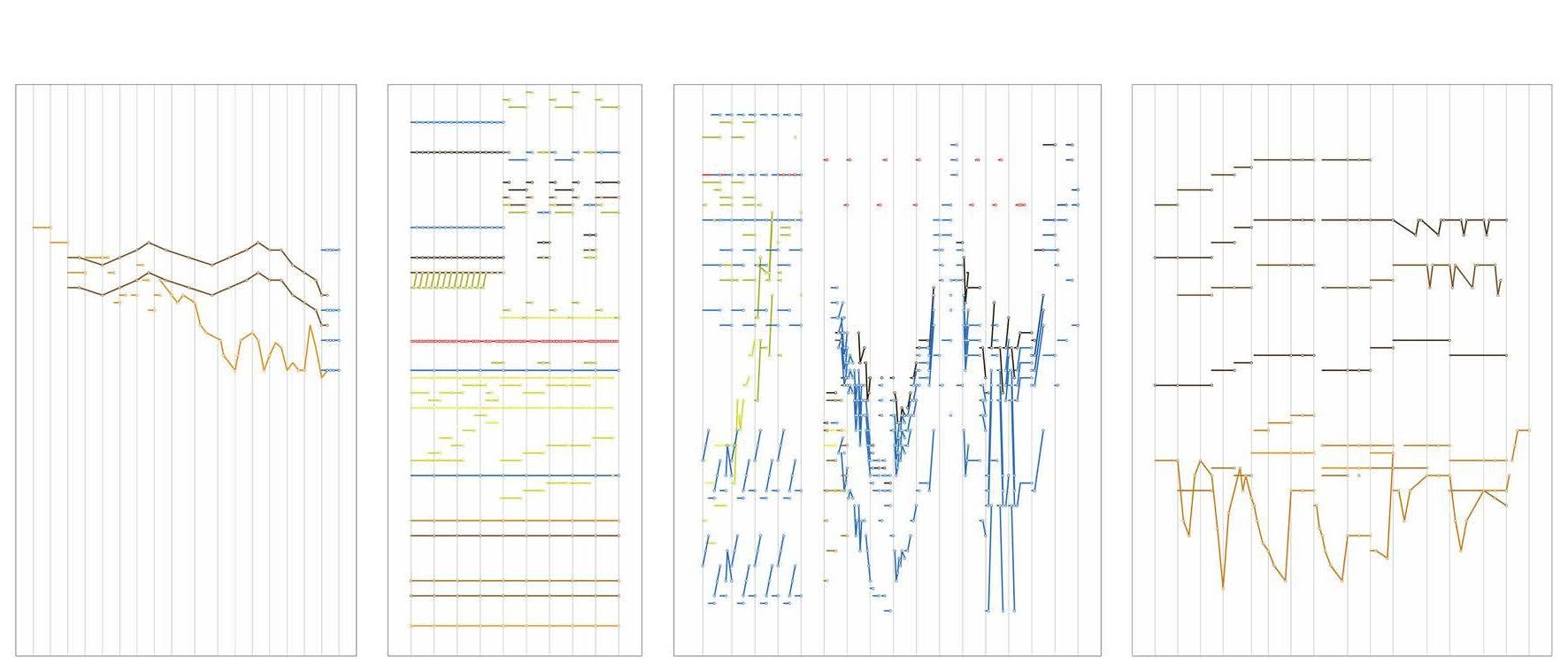
Theme 02 Soldiers
Consisting mainly of archi, the melodic character of the higher voices is a definite continuation of the upward or downward movement, expressing a color of perseverance and optimism.
Theme 03 Troops
The long lines of brass, accompanied by strong rhythmic and monotonous rhythms, express the color of horror.
Theme 04 The Composer
Consisting mainly of woodwind harmonies, the curved and blurred downbeat tune expresses a mysterious and hesitant color.
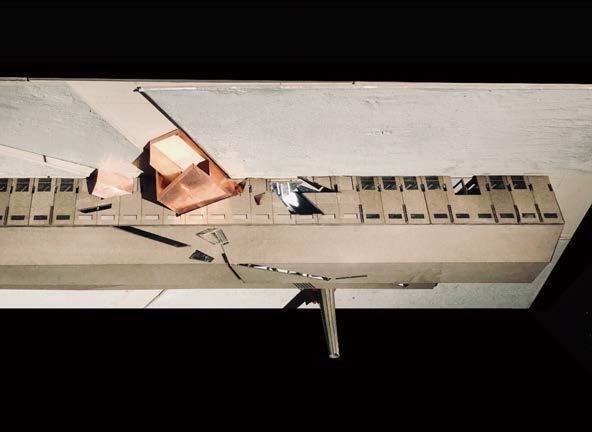





Strategy
Based on the analysis of Shostakovich's musical works, I insert conflicting dialogues into the powerful and monolithic factory by different scales, materials, and directions. The relationship between these two orders is complex. For instance, representing the image of
a "broken sword", the ‘soldier space’ alternates between tearing apart the factory's facade and creating internally severed spaces. By combining Shostakovich's routine pattern and spatial imagery, different spaces will evoke varied emotional experiences.
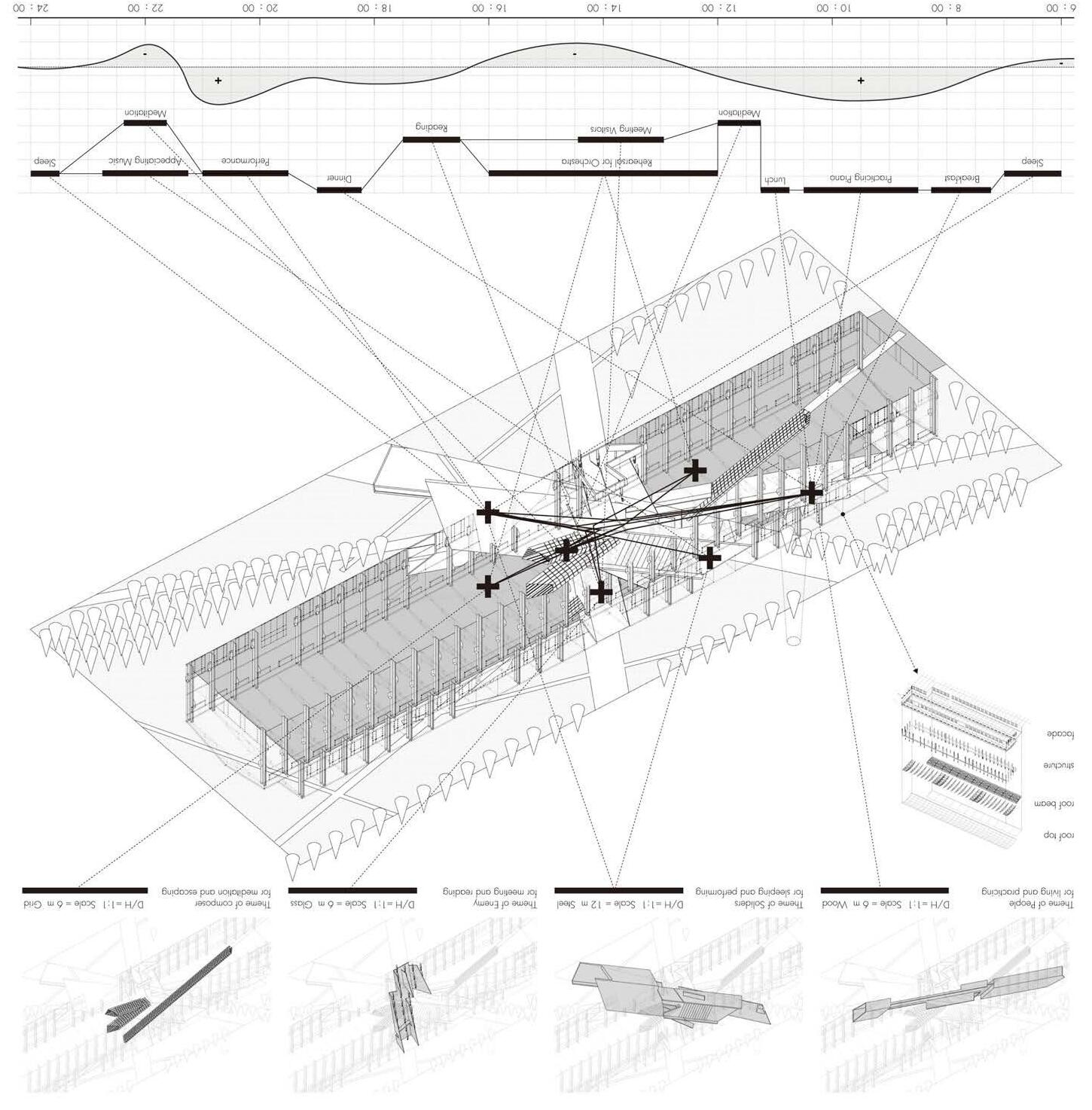
Shostakovich's Daily Pattern
Shostakovich's Arousal
As people
As Soldiers
As Troops As Composer




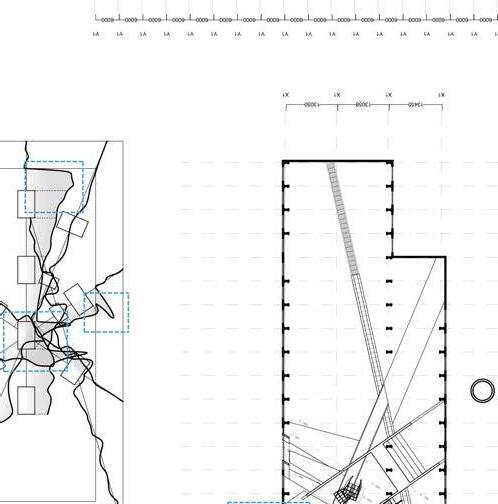



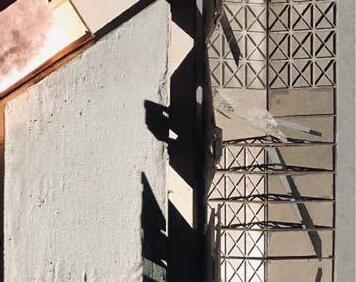
















Narrative
Shostakovich would awaken from restless dreams, practicing piano in the early morning. At noon, he wanders around the factory. And in the afternoon, he will dedicate time to rehearsals and reading. In the evening, he will perform either in his rehearsal room or outdoors. Four thematic activities intertwined in space, shaping his intricate inner world.





Detailed Section
dailypatternofShostakovich




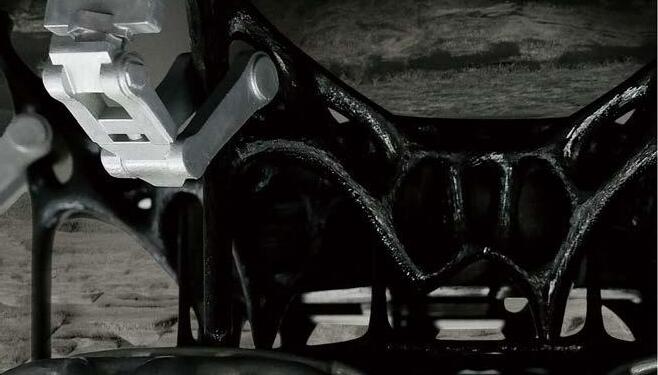



05 HOW ENVIROMENT MODULATE HUMAN EMOTION?
Mars Habitat
Experience Design of Vision and Tactility
Tsinghua Beijing & Tsinghua Shenzhen International Graduate School (Shenzhen) Joint Studio 2023.3-2023.6
Collaborator:Zixin Su, Chunyin Liu
Contribution:Concept 100%, Programming 50%, Modeling 80%, Representation 85%
Instructor: Prof.Weiguo Xu, Dean of School of Future Human Habitat Tsinghua SIGS


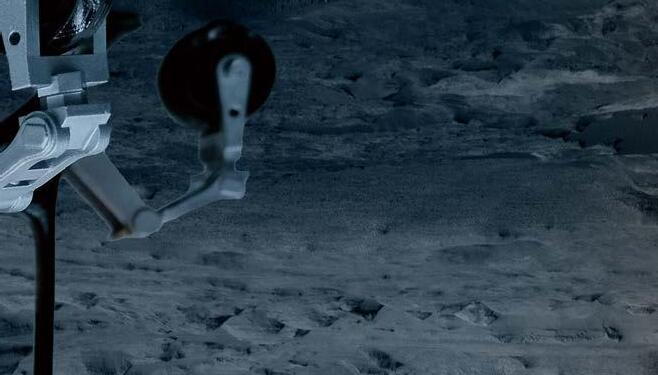

Problem : Color on Mars
The mineral composition on Mars, characterized by the presence of iron oxide (hematite), gives the planet a reddish-brown color. Red is believed to trigger intense emotional reactions in humans, such as excitement and tension. These emotions often manifest with increased left-hemisphere EEG activity. Prolonged exposure to such an environment may result in increased heart rate, elevated blood pressure, and diminished sleep quality. Consequently, the psychological challenges faced by individuals on Mars could indeed become a critical factor for the survival of the human species.


User Journey Map
Based on the synchronization of emotions between users and the digital life, we propose 6 primary scenarios. The Digital Life is composed of an inflatable membrane structure (as shown in the diagram below), which interacts with individuals through varying degrees of hardness. For example, when both are in a happy state, the inflation pressure of the membrane increases, allowing for experiences akin to playing ball games. Conversely, when the user is down, the pressure decreases, fostering a softer interaction between them.

Method : Color Therapy
Color therapy is a holistic healing approach that utilizes colors to enhance health and well-being. The practice of color therapy dates back to ancient India, as depicted in the illustration below. The main idea of color therapy is that different colors are linked to specific energies and vibrations. Then Exposure to these colors is thought to exert diverse effects on the mind and body.
Concept : Home as a Digital Life
We believe that the habitats on Mars should assume the role of companions, transforming residents from a state of typically limited interaction to active engagement, combined with the color therapy theory mentioned. Unlike traditional AI assistants, we posit that a Digital Life could be a form of a biological nervous system, possessing its own thoughts and emotions.
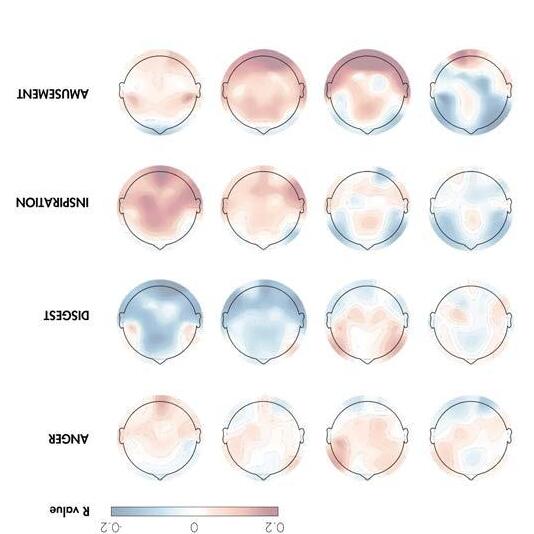


*Chen,J.#,Wang,X.#,Huang,C.,Hu,X.,Shen,X.,Zhang,D.*(2023). Alargefiner-grainedaffectivecomputingEEGdataset.ScientificData








Pipeline for Form Generation
Our concept is that homes on Mars should have the potential for customization. Therefore, we employed cellular automaton to define framework, allowing individuals to choose. Then we usd
kangaroo physics simulation to integrate the form of the inflatable membrane. Finally, we employed Culebras particle dynamics to generate the pipelines for the life support system.
I. Cellular Automaton Rules
1.Die due to loneliness
2.Die due to overcrowding
3.Black space survive
4.Gray space survive

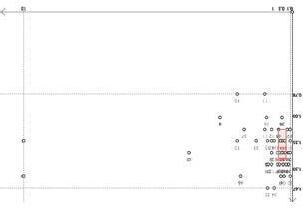







II. Kangeroo Physics Simulation
We utilized the inflation simulation in Kangaroo to achieve the desired spatial effects. To reduce computational complexity, we divided the inflation and collision into three steps. The 3.6m
frames were first computed to define the framework for the next step. The 1.2m units were then further computed on this basis, and finally, inflation was carried out based on the defined positions.




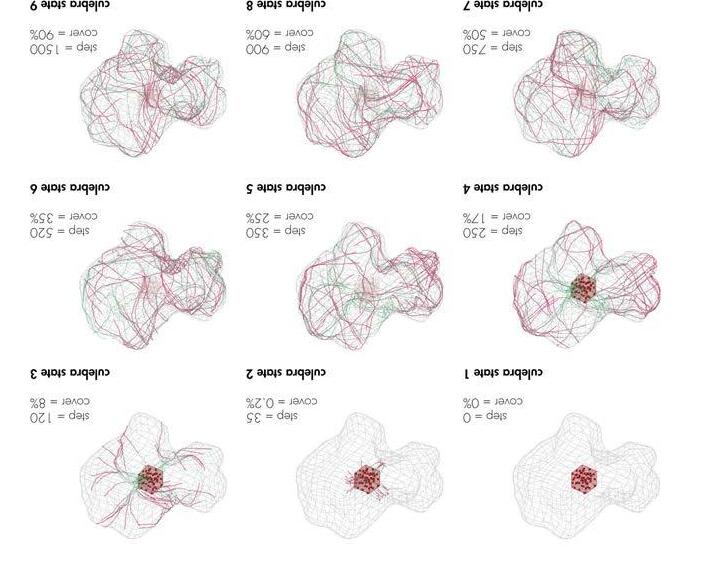
III.
Particle Dynamics
To achieve a more natural and organic pipeline form, we used Culebra for simulation. We initially defined the starting position, quantity, and movement speed of the particles. The entire process can be divided into three stages: the first stage involves particles coming into contact with the
in the second stage particles move onto the outer shell; and in the third stage, particle trajectories depart from the starting position, covering the entire outer shell.
Culebra
outer shell;
B. Cellular Automaton for 1.2m Units This step furthur defines the shape and function and the distribution of Digital Life in each room.
Black/White Propotion
Black/White Propotion
B. Simulation of 1.2m Units
C. Inflation of the Membrane
A. Simulation of 3.6m Units
A. Cellular Automaton for 3.6m Units This step ensures the overall form and combination of different rooms are feasible.
Selected Prototypes


Detailed Section
The detailed design is based on existing lunar bases and conceptual proposals for Mars habitats. The inner shell membrane retains the possibility of continued inflation, inspired by the design of spacecraft portholes. The outer shell refers to the construction methods of existing lunar bases, using inflatable membranes to form the main structure, filled with Martian soil, reinforcing agents and coated with protective substances. The energy platform draws on the MARCO POLO system proposed by the European Space Agency. The support structure is modeled after NASA's Athlete structure, generated through 500 iterations of graphical statics.














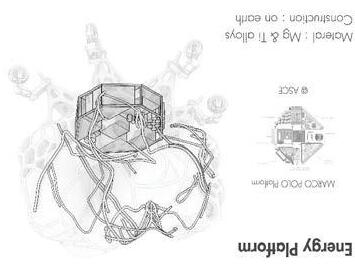





Generation of the Community Form
In the crater located in Mawrth Vallis, there are 40 Digital Life households. They have the ability to move to different locations based on different tasks, forming a nomadic society.
To achieve urban planning based on this mobile concept, we employed the Particle Swarm Optimization (PSO) algorithm. Four tasks were defined: charging, working, wandering, and resting. Different force inputs were then defined for trajectory simulation, resulting in the formation of a unique urban structure.





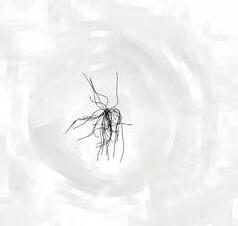

Systems of the Community
We defined several types of community zones: residential, industrial, green, energy, and undeveloped areas. The relationships between these zones are determined by the results of the previous simulations.At the same time, cluster analysis of



trajectories allows us to categorize roads into three levels. Main roads consist of two-way lanes, secondary roads are one-way lanes, while wandering paths are unpaved.


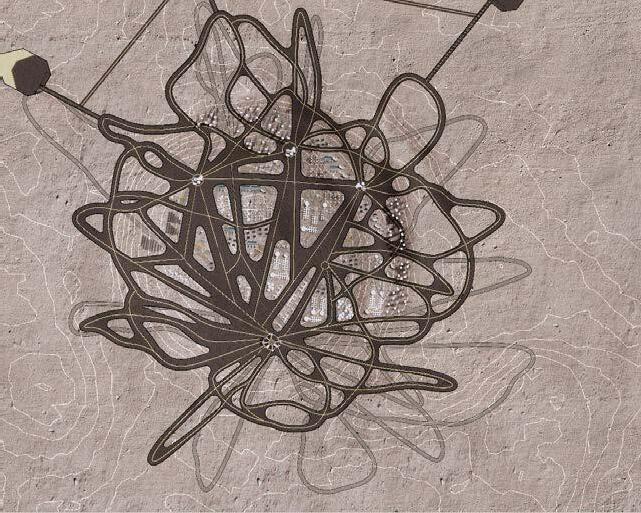






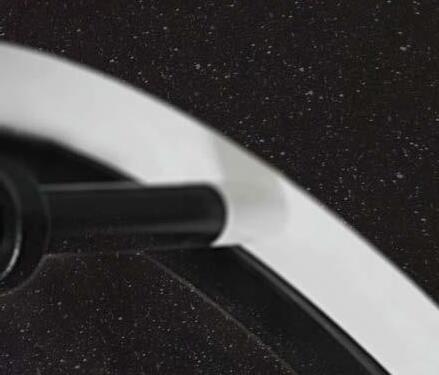













06 HOW EQUIPMENT FACILITATE HUMAN HEALTH? Landswimmer Ergonomic Desgin for Health and <1G Living Tsinghua Beijing & Tsinghua Shenzhen International Graduate School (Shenzhen) Joint Studio Apperance Patent CN. 202330543092.8 2023.3-2023.4
Problem: What Happens to Human Bodies in Space?
Due to the microgravity conditions in space, the human body encounters formidable challenges across various physiological systems. The nervous system is particularly susceptible, experiencing disruptions in brain regulation due to the absence of distinct day and night cycles. Subsequently, the fluid and circulatory systems are also affected...(as elaborated below). After adapting for about one and a half months, the functionality of the human body significantly diminishes compared to terrestrial conditions. Therefore, ensuring the physical and mental well-being of astronauts is a critical challenge.

*ImagescourtesyofNASA,NSBRI.
Nervous System
Crowding of the sulci can be seen at the vertex. The gyrus (asterisk) is the precentral gyrus (primary motor cortex).
*J.EffectsofSpaceflightonAstronautBrain
Structure as Indicated on MRI.
Muscular System
In space, the muscular system undergoes atrophy and decreased muscle mass. Weightbearing muscles, especially in the lower body, are particularly affected.


Circulatory System
The heart has to work less against gravity in microgravity, leading to a decrease in its mass and changes in its shape, resulting in changes of blood volume and blood pressure.

Skeleton System
In space, the microgravity environment leads to bone density loss, increased bone resorption, and changes in bone architecture.

Strategy: Swimming under 1 G




Method: Motion Capture
I conducted motion capture research on the freestyle swimming movements of members from the Tsinghua University swimming team. In this study, the athletes wore Xsens motion capture devices on land to simulate freestyle swimming for a duration of 45 seconds. In the subsequent data processing phase, selected the mid-section of the motion sequences for frame-by-frame analysis. Each cycle of the freestyle swimming motion lasted approximately 1 second.

Posture Analysis
Comparing motions obtained directly in the global coordinate system with those analyzed relative to the shoulders, swimming postures in the global coordinate system exhibit an X-shaped symmetry, with hand movements notably having a larger range than leg movements. The trajectory of hand movements in the sagittal plane can be roughly equivalent to an ellipse.

In the analysis relative to shoulders, hand movements are primarily in the lower part, while leg movements sometimes occur above. Shoulder-coordinate effectively reduces the spatial volume occupied by hand movements and increases the range of leg movements. Therefore, subsequent designs will follow the shoulder coordinate system.


Scenarios
During the space travel between Earth and Mars, land swimmer proves to be a versatile tool in supporting astronauts' physical well-being across different scenarios.
Its utility extends beyond the confines of space, starting with its application on Earth. Acting as a home or gym fitness apparatus, it not only serves the practical purpose of exercise but also offers an engaging and enjoyable workout experience for users.
When utilized within spacecraft or space stations, the equipment's compact design doesn't compromise its effectiveness. It efficiently integrates muscle resistance training and aerobic exercises, presenting a holistic health solution tailored for astronauts.
Looking ahead to the Martian landscape, where gravity is only a third of Earth's, this land-based swimming equipment could become a focal point for training in homes or community centers. This equipment can play a pivotal role in addressing the diverse health needs of individuals living or working on the Red Planet.

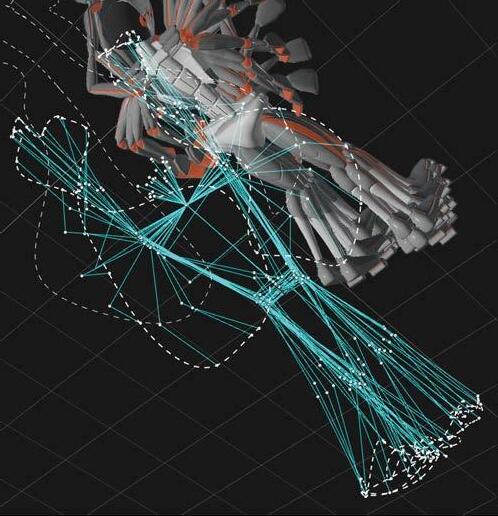



Diagram of a Moment
The diagrams are obtained by combining model photos and CAD drawings.

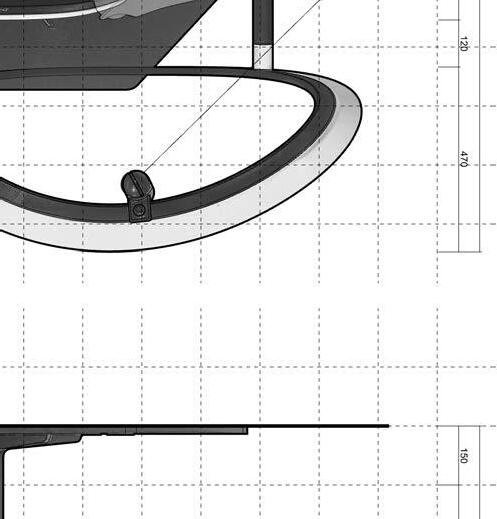




Prototype Model
The model is 3D printed at 1:5 scale, with different colors of paint and gloss applied. Design takes into account the rotation and movement of each joint.








RIGHT VIEW
TOP VIEW
